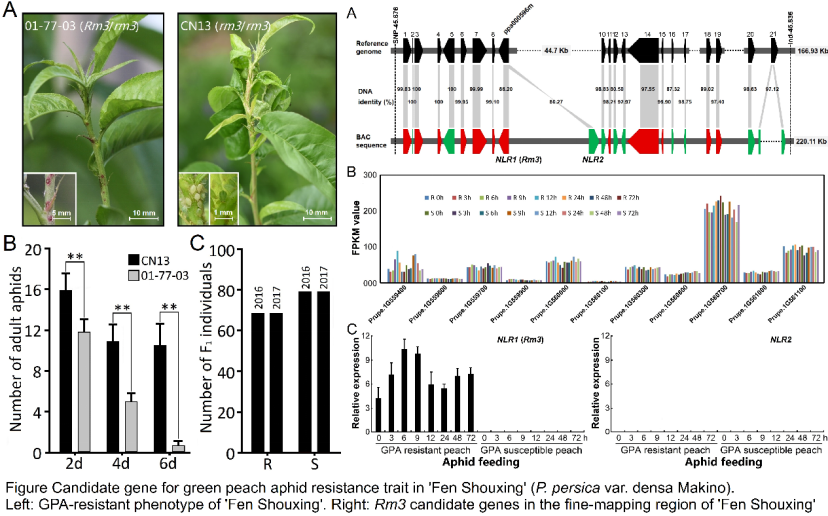Source: Zhengzhou Fruit Research Institute
Recently, a paper entitled “The NLR gene Rm3is a strong candidate gene for the dominant green peach aphid (Myzus persicae Sülzer) resistance trait in peach” was published by Journal of Experimental Botany. In the paper, ZZFRI researchers report the genetic analysis and cloning of the first resistance gene Rm3 for M. persicaeinpeach. Findings provide new insights into the genetic mechanism underlying insectresistance intree plants and uncover a useful diagnostic tool for early seedling selection in peach breeding programmes.

Bulk segregant analysis (BSA) mapping in a segregating progeny delimited Rm3 to an interval spanning 160 Kb containing 21 genes on chromosome 1. RNA-seq data were analysed for candidate genes, and while no evidence of candidate genes was identified, chromosomal structural variations were predicted around a nucleotide-binding site–leucine-rich repeat (NLR) gene (ppa000596m) within the Rm3 fine-mapping interval. After bacterial artificial chromosome (BAC) library construction for a GPA-resistant peach cultivar and the sequencing of three target BAC clones, a chromosomal structural variation encompassing two novel TIR–NLR-class disease resistance (R) protein-coding genes was identified, and the expressed NLR gene (NLR1) was identified as a candidate gene for M. persicae resistance. Consistent with the proposed role in controlling GPA resistance, NLR1 was only expressed in the leaves of resistant peach. A molecular marker designed based on the NLR1 sequence cosegregated with the GPA-resistant phenotype in 713 progenies, 162 peach cultivars and 14 wild relatives, accounting for the dominant inheritance of the Rm3 locus. This information can be exploited to facilitate GPA-resistant peach breeding.
The research was supported by the National Natural Science Foundation of China (32071800and 31701880), National Key Research and Development Program of China (2019YFD1000801), and Chinese Academy of Agricultural Sciences (CAAS-ASTIP-2021-ZFRI).
More details are available on the link below:
https://academic.oup.com/jxb/advance-article/doi/10.1093/jxb/erab506/6432445
By Pan Lei (panlei@caas.cn)
